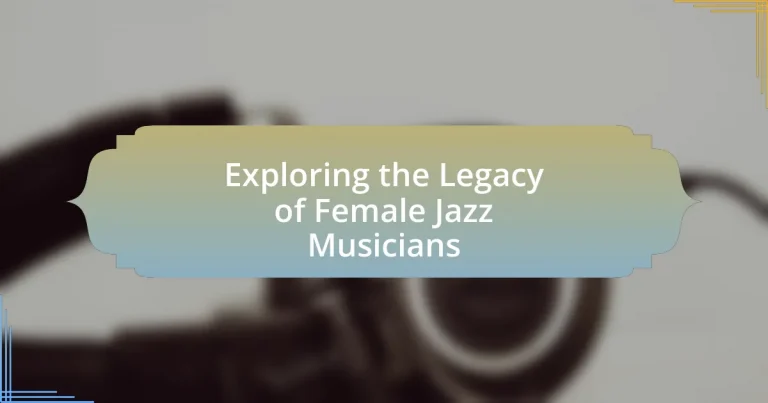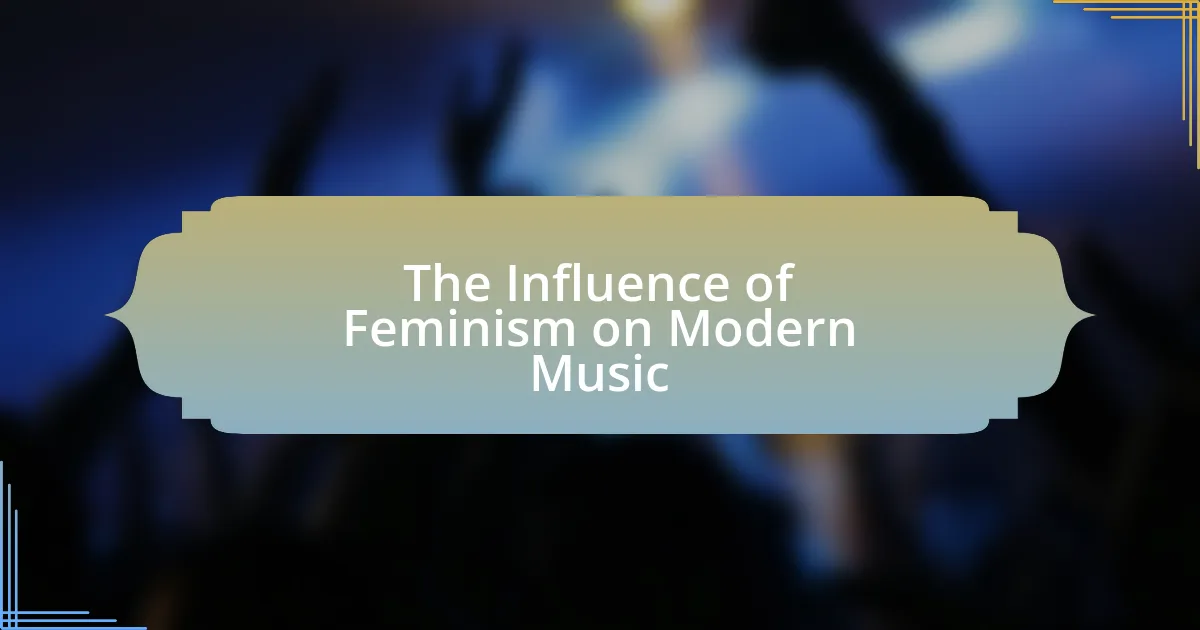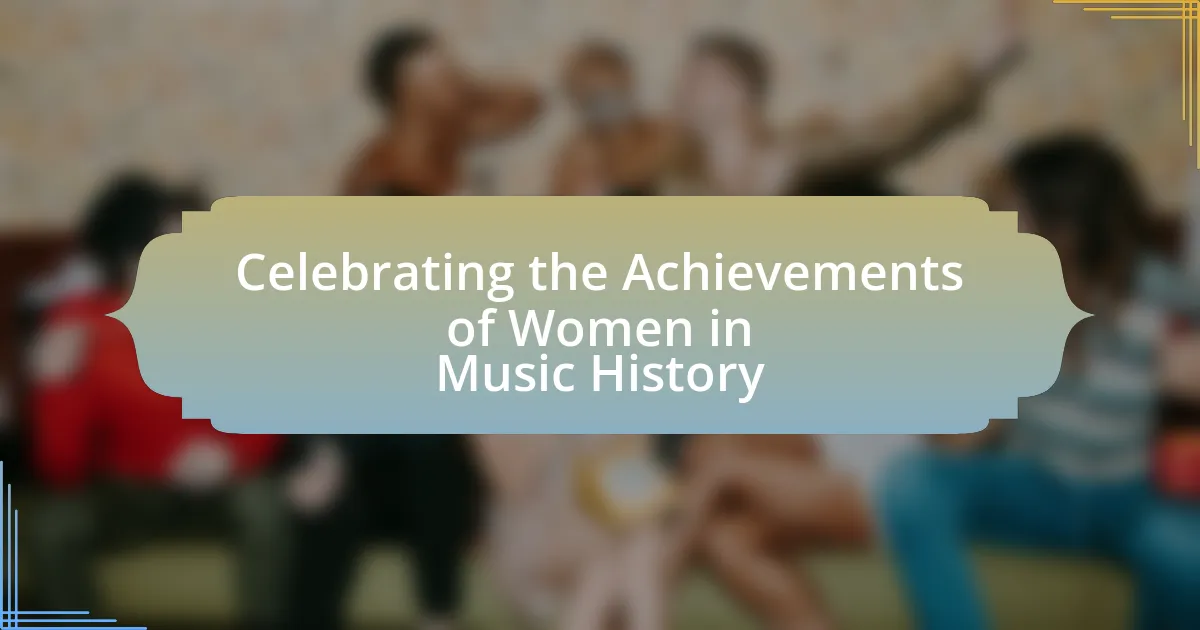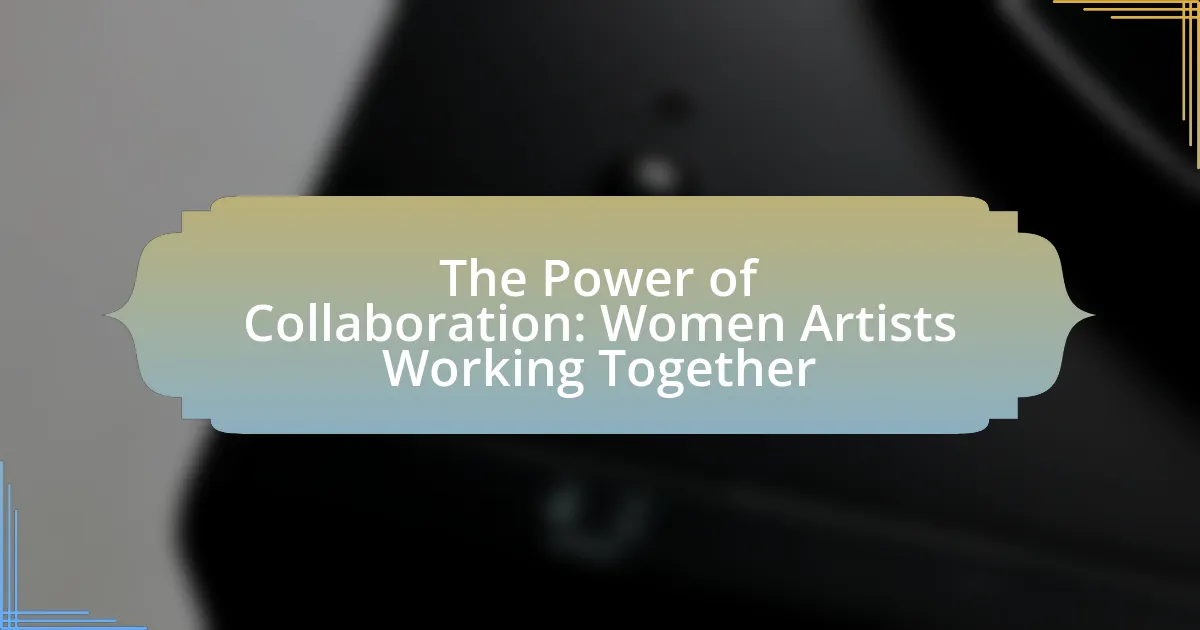The article explores the legacy of female jazz musicians, highlighting their significant contributions to the genre and the barriers they faced in a male-dominated industry. It discusses the influence of iconic figures such as Billie Holiday, Ella Fitzgerald, and Sarah Vaughan, as well as contemporary artists like Esperanza Spalding and Norah Jones. Key topics include the impact of societal changes on women’s roles in jazz, the importance of recognizing female musicians, and the resources available for learning about their contributions. The article emphasizes the need for greater visibility and support for female jazz artists to inspire future generations and promote diversity within the music industry.
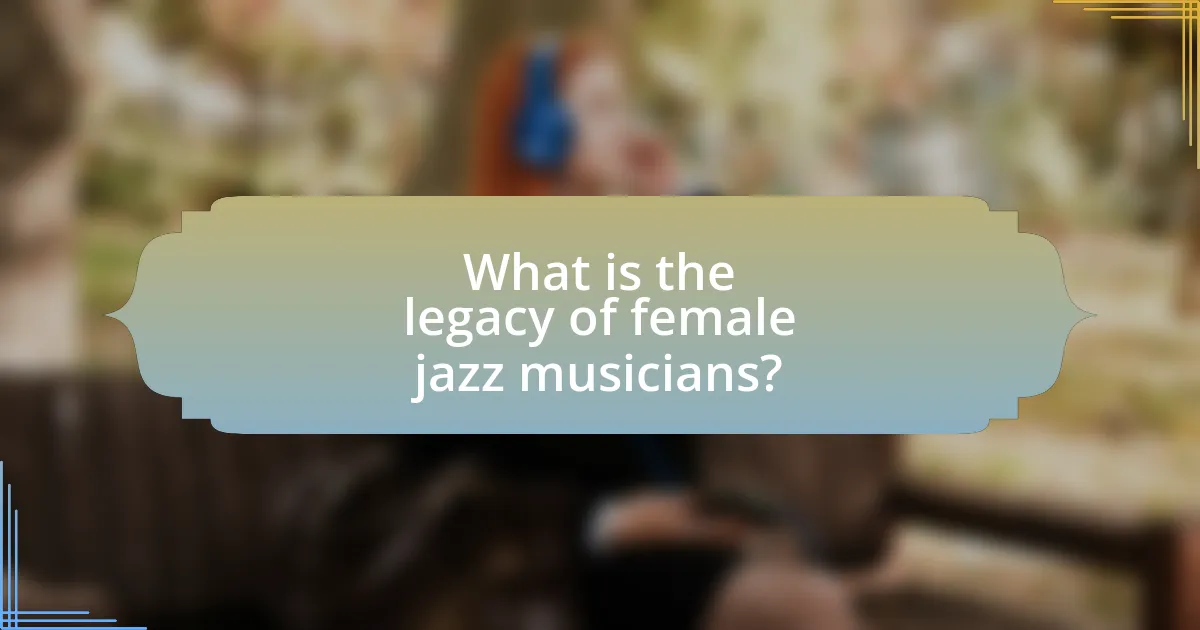
What is the legacy of female jazz musicians?
The legacy of female jazz musicians is characterized by their significant contributions to the genre, which have shaped its evolution and expanded its boundaries. Notable figures such as Billie Holiday, Ella Fitzgerald, and Sarah Vaughan not only showcased exceptional vocal talent but also broke barriers in a male-dominated industry, influencing generations of artists. Their innovative styles and emotional depth in performance have left an indelible mark on jazz, as evidenced by Holiday’s pioneering use of phrasing and Fitzgerald’s mastery of scat singing. Furthermore, contemporary artists like Esperanza Spalding and Norah Jones continue to draw inspiration from these trailblazers, ensuring that the impact of female jazz musicians remains vital in today’s music landscape.
How have female jazz musicians influenced the genre?
Female jazz musicians have significantly influenced the genre by expanding its musical boundaries and challenging societal norms. Pioneers like Billie Holiday and Ella Fitzgerald introduced unique vocal techniques and emotional depth, shaping jazz standards and influencing countless artists. Additionally, musicians such as Mary Lou Williams and Carla Bley contributed innovative compositions and arrangements, integrating elements from various musical styles and paving the way for future generations. Their contributions have not only enriched the musical landscape but also promoted greater representation and recognition of women in jazz, as evidenced by the increasing number of female artists in contemporary jazz scenes.
What are some key contributions made by female jazz musicians?
Female jazz musicians have made significant contributions to the genre, including pioneering new styles, expanding the role of women in music, and influencing future generations of artists. Notable figures such as Billie Holiday revolutionized vocal jazz with her emotive singing and unique phrasing, while Ella Fitzgerald’s scat singing and improvisational skills set new standards for vocal performance. Additionally, composers like Mary Lou Williams and Carla Bley brought innovative arrangements and compositions to jazz, showcasing the creative potential of women in a male-dominated field. These contributions have not only enriched jazz music but have also paved the way for greater representation and recognition of female artists in the industry.
How did societal changes impact the roles of female jazz musicians?
Societal changes significantly expanded the roles of female jazz musicians, particularly during the 1920s and 1960s, as women began to challenge traditional gender norms. The women’s suffrage movement and the rise of feminism allowed female musicians to gain visibility and assert their presence in a male-dominated industry. For instance, artists like Billie Holiday and Ella Fitzgerald emerged during this time, showcasing their talents and paving the way for future generations. Additionally, the civil rights movement further empowered women of color in jazz, leading to increased opportunities and recognition. This shift in societal attitudes not only allowed women to perform and record music but also to take on leadership roles within bands and the broader jazz community.
Why is it important to recognize female jazz musicians?
Recognizing female jazz musicians is important because it acknowledges their significant contributions to the genre and promotes gender equality in a historically male-dominated field. Female jazz musicians, such as Billie Holiday and Ella Fitzgerald, have shaped the evolution of jazz through their innovative styles and performances. Studies show that women have been instrumental in the development of jazz, yet their achievements are often overlooked. For instance, a report by the International Jazz Day organization highlights that female artists represent only a small percentage of recognized jazz musicians, underscoring the need for greater visibility and appreciation of their work. This recognition not only honors their legacy but also inspires future generations of female musicians to pursue careers in jazz.
What barriers did female jazz musicians face historically?
Female jazz musicians historically faced significant barriers including gender discrimination, limited access to performance opportunities, and societal expectations regarding women’s roles. Gender discrimination often manifested in the form of exclusion from prominent bands and clubs, as many venues preferred male musicians. Limited access to performance opportunities was compounded by a lack of support from record labels and promoters, who frequently overlooked female talent. Societal expectations further restricted women, as they were often discouraged from pursuing careers in music, which was viewed as a male-dominated field. These barriers collectively hindered the recognition and advancement of female jazz musicians throughout history.
How does recognition of female jazz musicians affect contemporary music?
Recognition of female jazz musicians significantly influences contemporary music by promoting diversity and inspiring new generations of artists. The acknowledgment of their contributions challenges traditional gender roles within the music industry, leading to increased representation of women in various genres. For instance, artists like Esperanza Spalding and Norah Jones have emerged as prominent figures, showcasing the impact of female musicians on modern jazz and beyond. Studies indicate that diverse musical influences enhance creativity and innovation, suggesting that the recognition of female jazz musicians enriches the overall landscape of contemporary music.
What are the notable achievements of female jazz musicians?
Female jazz musicians have made significant contributions to the genre, with notable achievements including pioneering new styles, winning prestigious awards, and influencing generations of artists. For instance, Billie Holiday’s emotive singing style transformed jazz vocalization, while Ella Fitzgerald’s scat singing showcased technical virtuosity, earning her 14 Grammy Awards. Additionally, Mary Lou Williams was a key figure in the development of bebop and became the first woman to have a big band, further solidifying her impact on jazz history. These accomplishments highlight the essential role women have played in shaping jazz music and its evolution.
Which female jazz musicians have received significant awards and honors?
Significant awards and honors have been received by female jazz musicians such as Ella Fitzgerald, who won 13 Grammy Awards and the Grammy Lifetime Achievement Award; Billie Holiday, who was posthumously awarded a Grammy Lifetime Achievement Award; and Esperanza Spalding, who won the Grammy Award for Best New Artist in 2011, becoming the first jazz artist to receive that honor. Additionally, Nancy Wilson received three Grammy Awards and was recognized with a star on the Hollywood Walk of Fame. These accolades highlight the impactful contributions of these musicians to the jazz genre and their lasting legacy in music history.
How have female jazz musicians shaped the evolution of jazz styles?
Female jazz musicians have significantly shaped the evolution of jazz styles by introducing innovative techniques, diverse influences, and unique perspectives. Pioneers like Billie Holiday and Ella Fitzgerald expanded vocal jazz through emotional expression and improvisation, while instrumentalists such as Mary Lou Williams and Carla Bley contributed to the development of big band and avant-garde jazz, respectively. Their contributions not only challenged gender norms but also enriched the genre, leading to the incorporation of various musical elements and styles, such as blues, swing, and bebop. The impact of these musicians is evident in the ongoing evolution of jazz, as their legacies continue to inspire new generations of artists.
How can we explore the contributions of female jazz musicians today?
We can explore the contributions of female jazz musicians today by analyzing their recordings, performances, and influence on contemporary jazz. Female jazz musicians such as Esperanza Spalding and Terri Lyne Carrington have made significant impacts through innovative compositions and leadership roles in ensembles. For instance, Spalding’s Grammy Award-winning album “Emily’s D+Evolution” showcases her unique blend of jazz with other genres, highlighting the evolving nature of jazz influenced by female artists. Additionally, organizations like the International Women in Jazz promote visibility and support for female musicians, further emphasizing their contributions to the genre.
What resources are available for learning about female jazz musicians?
Books, documentaries, and online courses are valuable resources for learning about female jazz musicians. Notable books include “Sisters in Jazz” by Leslie Gourse, which profiles influential female jazz artists, and “Women in Jazz” by Mary E. Davis, which explores the contributions of women to the genre. Documentaries such as “The Girls in the Band” highlight the experiences of female jazz musicians throughout history. Additionally, online platforms like Coursera and MasterClass offer courses focusing on jazz history, often featuring sections dedicated to female artists. These resources provide comprehensive insights into the impact and legacy of women in jazz.
Which documentaries and books highlight the stories of female jazz musicians?
Documentaries and books that highlight the stories of female jazz musicians include “The Girls in the Band,” a documentary that chronicles the contributions of women in jazz from the 1920s to the present, and “Sisters in Jazz,” which features interviews and performances of female jazz artists. Additionally, the book “Women in Jazz” by Mary Lou Williams provides an in-depth look at the lives and careers of female jazz musicians. These works collectively showcase the significant impact and legacy of women in the jazz genre, emphasizing their often-overlooked contributions to the music industry.
How can music education incorporate the legacy of female jazz musicians?
Music education can incorporate the legacy of female jazz musicians by integrating their compositions, performances, and historical contributions into the curriculum. This approach can include teaching students about influential figures such as Billie Holiday, Ella Fitzgerald, and Mary Lou Williams, highlighting their unique styles and the challenges they faced in a male-dominated industry. Additionally, music programs can feature workshops and masterclasses led by contemporary female jazz artists, fostering a connection between past and present. Research indicates that representation in music education enhances student engagement and appreciation for diverse musical traditions, making it essential to include female jazz musicians’ legacies in educational settings.
What are some practical ways to support female jazz musicians now?
To support female jazz musicians now, individuals and organizations can actively promote their work through social media platforms, ensuring wider visibility and engagement. This can be achieved by sharing their performances, albums, and achievements, which helps to elevate their profiles in a predominantly male-dominated industry. Additionally, providing financial support through crowdfunding platforms or purchasing their music directly contributes to their sustainability as artists. Research indicates that female musicians often face barriers in funding and exposure, making these actions crucial for their success. Furthermore, creating and participating in mentorship programs can foster the next generation of female jazz musicians, providing them with guidance and opportunities that are often lacking.
